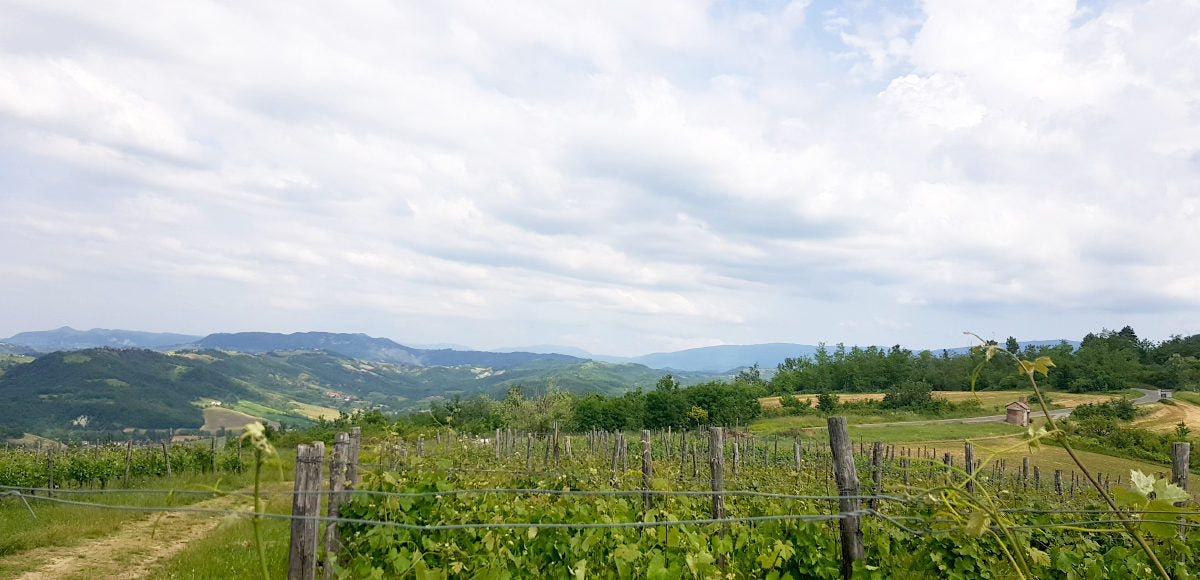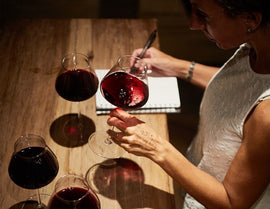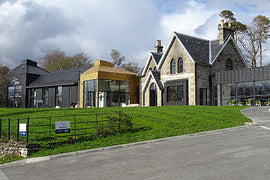Colli Tortonesi
French historian Jules Michelet used to begin his lectures on British history, with the seemingly unnecessary proclamation, “Messieurs, l’Angleterre est une ile.” “You guys, England is an island.” Obvious for sure, but it sharpens the focus: there is, after all, a significant difference between “simply knowing that Britain is an island” and “whether we interpret its history in the light of that fact, which thus takes on a significance of its own.”*
Take this tack with Italy/Italian wine, and we might lead with: Italy is mostly uphill. The fact that it occupies a peninsula (Appenine) named for the mountain range that traverses it, is probably the biggest clue, but if (like me) you haven’t spent much time there you might be surprised to learn that fully 75% of Italy is hills and mountains. It is a geographical characteristic that has had a dramatic effect on pretty much every aspect of its development, cuisine and wine included. For centuries, getting from one town to another was a huge hassle, and as a result, products grown successfully in one valley might never make it to the valley next door. So even though the Colli Tortonesi DOC, our destination this month, is technically part of Piedmont, the northeastern region famed for its Barbaresco and Barolo, it very much occupies its own altitude, offering vistas unavailable anywhere else, requiring a separate summit. Up we go!
Located in the southeastern part Piedmont, adjacent to Oltrepò Pavese in Lombardy, Colli Tortenesi was founded by the Ligurians, before becoming a Roman colony called Derthona in 148 BCE, the first such outpost under imperial rule west of the Po River Valley. The area has a transitional topography of hills and valleys as it rises from the plains of the Po River to heights of 1,700 meters in the Apennines, all of which contribute to the diversity of soil and climate. Much of the soil, formed during the Tortonian age, between 5 and 15 million years ago, is a mix of calcareous clay, with ancient marine deposits, limestone and a surface layer of sand. The climate is humid, influenced positively by the Ligurian sea and receives the lowest rainfall in the region, with a considerable temperature range throughout the day, which contributes to the intense aromatics of the wine. Throughout the Middle Ages, the area was planted with local varietals like Barbera, Cortese, Croatina and Timorasso. However, when the phylloxera epidemic devastated the area in 1879, Timorasso was excluded from replanting because of its low yields and, instead, Cortese, was widely planted owing to its much easier growing attributes. After the second World War, the area was largely converted to red grapes and, in 1973, when the DOC was awarded, Barbera and Cortese were the focus grapes.
Indeed Timorasso, a highly distinctive white grape and Colli Tortenesi’s only autochthonous varietal, was on the verge on extinction by 1987, when local winemaker Walter Massa began acting on his hunch that some of the family vineyards were better suited to growing white grapes. The (eventual) result has been a Timorasso renaissance as others have discovered that this thick and waxy skinned varietal produces age-worthy and distinguished white wine, boasting floral notes, bright acidity and orchard fruit flavors in its youth, and capable of developing petrol, almond and honeyed characteristics as it matures. Timorasso has been alternately likened to Chablis, Riesling and Chenin Blanc which is proof enough of its uniqueness.
Our example this month comes from the vines of La Vecchia Posta in the village of Avolasca, amid the foothills of the Ligurian Apennines. Roberto Semino was born and raised in Tortona, the provincial capital 15 miles away, and grew up spending the summer in Avolesca with his grandfather. One of the first in the area to farm organically (he started in the 1980’s) Roberto makes two bottlings of Timarosso; one from their highest altitude vineyard, and another “Il Selvaggio” (The Wild One) from vines deliberately scattered throughout his property. We are featuring the latter; it is an ideal ambassador for Timorasso’s considerable appeal, drinking well now, and ageable for a few years to come.
La Vecchia Posta also makes our red selection, which comes from the Ciliegiolo (pronounced chee-lye-JO-lo) grape grown, unlike Timorasso, in several Italian spots including Tuscany, Umbria, Abruzzo and Liguria, where it is mostly used as a blending foil for its cousin Sangiovese. There are an increasing number of single bottlings however, especially in Liguria, but this is the first one I’ve encountered in Piedmont. It’s a natural fit though, as the grape (whose name means “cherry” in Italian - a reference both to the varietal’s physical appearance and flavor profile) thrives in warm, dry climates like Colli Tortonesi.
|
La Vecchia Posta il Sevaggio Timorasso 2021 |
|
|
Region: Collo Tortonesi, Piedmont Italy |
About the Winery: La Vecchia Posta is a family-run farm and one of the smallest Timorasso producers in the region, producing 9,000 bottles/year (half of their total production) Established in 2002, they recovered abandoned land and now have 4 hectares of certified organic vines (2 of Timorasso) at 425m altitude and also run an agriturismo (restaurant & B&B) where the wines can be tasted. Vineyards elevations, hovering around 400 meters above sea level, are the key to the vibrancy of Roberto’s wines. Vines range in age from about 15 to 30 years. Trellising is Guyot, though Roberto says he favors pruning the vines “more as a ‘y’ to divide the energies coming from the roots.” About the Winemaking: Says Roberto: “The vine is a spirit that wanders between meadows and acacias, between rows and uncultivated, gathering in the wind all the aromas of these high lands. Every time we planted a vineyard, we put inside some rows of Timorasso to see how it grows in different kinds of soil.” This wine is pressed and fermented with native yeasts in stainless steel. The wine is then aged in stainless steel tank on the lees with light battonage. After 9 months the wine is bottled with very little sulfur. Tasting Notes: Classic Timarosso combination of acacia flower on the nose, a palate composed of striking minerality, acidity, orchard fruit, and full body, finished by a kiss of salt. |
|
Winemaker: Roberto Semino |
|
|
Price per bottle / Price per case $32.99/$356.30 |
|
|
Suggested Food Pairing: Fonduta (Piedmontese cheese fondue) Risotto w/ white truffle Raw vegetables with bagna cauda (the local dip made from hazelnut oil, anchovies, peppers, garlic and cream.) |
|
|
La Vecchia Posta Rosso Ciliegiolo 2021 |
|
|
Region: Collo Tortonesi, Piedmont Italy |
About Winemaking: From a historic vineyard in Tassare, planted in the 1960s by the Baiardi family and now cultivated organically by Vecchia Posta. Ciliegiolo is a red grape variety of central and northwestern Italy, something of an obscurity in past decades but now undergoing a renaissance. The grape's name comes from an Italian word for cherry, a fruit which Ciliegiolo wines resemble both in color and aroma. It is this character that has prompted the vine's renaissance. Spends 5 months in stainless steel before bottling. Farming in tune with the land is essential to Roberto. “To respond to climate change, we are starting with soil management, with some cover crops between the rows, part of the gradual lightening of the soil to let the few rains penetrate.” Careful canopy management and green harvests are further “operations that, together with the biological method, help us in the natural world in our qualitative growth.” Hand picking is a given. Grapes are transported to the press pad in small boxes to ensure they remain uncrushed, and therefore unoxidized, even on the short trip from vine to cellar. Tasting Notes: A nose vibrant with bright cherries, purple flowers, and baking spices. On the palate, the wine is velvety and medium bodied. |
|
Winemaker: Roberto Semino |
|
|
Price per bottle / Price per case $27.99 $302.30 |
|
|
Suggested Food Pairing: Charcuterie Aged cheeses Walnut Pesto Pasta Risotto al Finocchio (see recipe) |
|
- 6 cups diced fresh in-season tomatoes from about 4 large
- ¾ cup extra virgin olive oil divided, plus more for drizzling
- 1 medium yellow onion very thinly sliced
- 1 medium bulb of fennel cored and very thinly sliced
- 2 teaspoons fennel seed crushed with a mortar or back of a knife
- 3 teaspoons kosher salt divided, plus more to taste
- 1 cup arborio rice
- ½ cup dry white wine
- 1 ½ - 2 cups of water *see note
- freshly cracked black pepper to taste
- ¼ cup chopped fresh parsley
- ¼ cup chopped fresh mint
- ¼ cup chopped fresh dill
- Place the tomatoes in a strainer set over a bowl and allow them to drain for about 15 minutes. Transfer the liquid from the bowl into a measuring cup, then fill with water to get 2 ½ cups.
- Heat ¼ cup olive oil in a large heavy bottomed pot or dutch oven over medium heat. Add the onion and fennel and sauté until softened and barely starting to turn golden, about 10 minutes. Stir in the fennel seeds and 1 ½ teaspoons salt for about 1 minute more.
- Add the arborio rice, stir, and cook for about 1-2 minutes to toast the rice. Add the white wine and stir until fully absorbed.
- Add ½ cup of the tomato water and stir. When the rice absorbs all of the liquid, continue adding more tomato water one ½ cup at a time, while stirring, until all the liquid is used up.
- Stir in the tomatoes and cook for about 2-3 minutes. They will release some liquid as they start to cook down.
- Add the remaining 1 ½ teaspoons of salt and season with black pepper. Give the risotto a taste and adjust the seasoning as needed. While tasting, take note of how done the rice is. When the rice is cooked through but still al dente, it's done.
- Remove the risotto from the heat and vigorously stir in the remaining ½ cup of olive oil, then the herbs, reserving some on the side for garnish.
- Spoon the risotto into bowls, drizzle with more olive oil and sprinkle with more herbs. Serve immediately.
*(Appropriating this story from Leszek Kolakowski’s Main Currents of Marxism where he uses it to explain starting with the similarly mind-blowing: “Karl Marx was a German philosopher.)
Find similar articles
italian wine club



